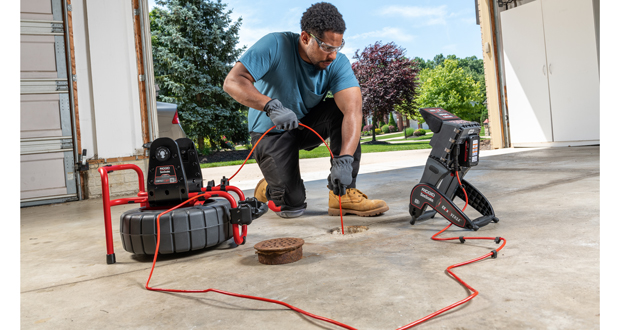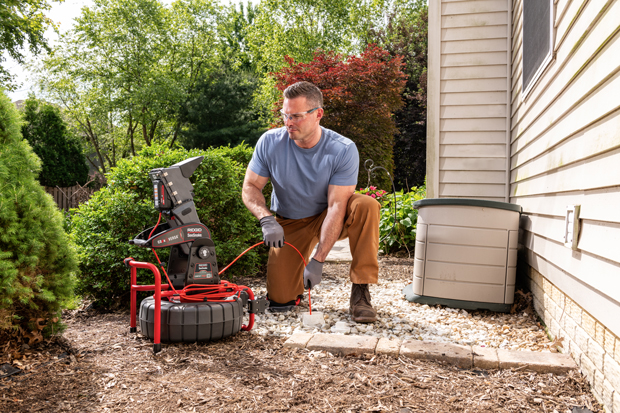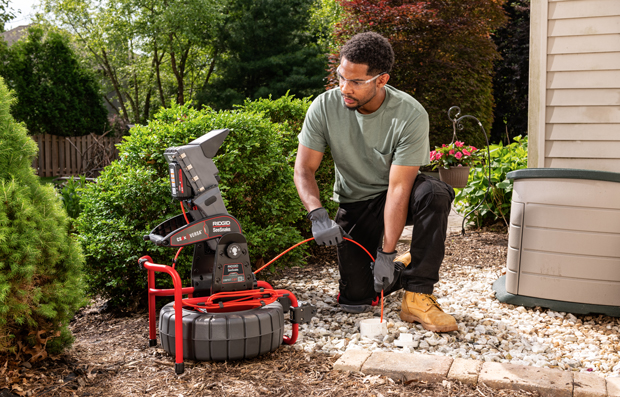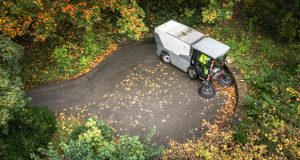Many drain cleaners and plumbers will acknowledge this: having a pipe inspection system in your van has almost become a given. Either it is to work more efficiently on a job – no more working blindly, or to prove to your customers about the high quality you provide as a professional of trades.
Choosing a pipe inspection system has never been easy; there are so many different systems out there and so many points on which you can value such a system. Taking the time to research and consider all options against each other is an important task that will bring you much added value.
We are excited to talk about the RIDGID options we have in our portfolio and share with you our experience on the topic of choosing the right equipment for the job.
Price vs. Return on investment (ROI)
When you’re looking for a new system, price and ROI are often the first things taken into consideration. Price is certainly an important factor, but typically less expensive reels are smaller and meant only for smaller-sized pipes. When using a reel in a pipe that was 100mm larger than the maximum diameter the reel was called for, you can easily get the reel damaged by kinking the cable. (Kinking a cable means the system does no longer fit to do inspections, even though it may still give some image) The best action would be to send the camera into repair and evidently, that comes at a cost. Taking some time up front to think about the job sites you mostly visit, and the size of pipes typically found there can go a long way in preventing unnecessary repairs and can help you maximise ROI.
What pipe type and size do you frequently see on the job site?
Starting from this question, you can already say if most of the work takes you to “residential” type systems or “industrial” ones.
Residential systems are smaller in size, have more bends, and usually start from 32mm up to 150 or 200mm. In this range of pipe sizes, RIDGID offers 3 System types for different pipe capacities and with different cable flexibilities.
If you mostly work in laterals with multiple bends, you probably want a moderate flexible push cable to negotiate those bends, yet able to push far enough so you can have the entire pipe inspected.
If you mostly work in larger diameters with longer straight runs, you probably better opt for a larger system equipped with a stiffer push cable.
Working with a cable too flexible for the pipe size you’re inspecting, may cause the camera to turn on itself and kink, or when it has a smaller camera head, you just may not be able to see the entire inside of the pipe, which leaves you unsatisfied with the performance of your equipment.
Drive for Technology
Technology is constantly evolving for all types of equipment and camera systems. We still see around the camera systems that we manufactured 25 years ago, they still perform on the job, but technology has come a long way since those first camera systems were released.
Today our camera systems are equipped with TruSense technology.
All the camera heads feature multiple sensors that give you information on the camera head’s inclination in-pipe and provide you with a superior image quality through HDR camera technology. HDR or High Dynamic Range is not to be confused with High Definition. Our cameras are designed to work in an in-pipe environment, so we want the best image clarity ratio possible. HDR technology corrects the black/ white balance and comes back with a clearer image.
TiltSense conveys the camera’s angle or inclination in-side the pipe. It can be particularly interesting to identify hidden pipe defects. For instance, there is a lot of debris left inside the pipe you’re inspecting, which can make it difficult to identify whether the pipe has cracked somewhere along the line. The inclinometer indication is not calibrated but gives useful insights that can be used to help you diagnose certain defects or installation errors.
All these technologies are built on the TruSense Platform. They will be receiving the newest product updates and functionalities when they are released to the public, making these cameras ever-evolving systems that can easily be a partner for many years to come when cared for.
Durability
Durability is an important factor to consider when you’re selecting the right camera system for the job. For demanding job sites, such as the underground drainage environment, you need a specific camera that is built for that job.
RIDGID launched its first line of inspection cameras in 1996, allowing professionals to diagnose in-ground pipe issues more easily. For 25 years, the RIDGID brand has been delivering durable underground products that have enabled users to grow and build their business year after year.
Furthermore, the SeeSnake equipment is truly designed to be used in the underground environment. Originally designed for deep-sea applications, the RIDGID camera heads are built from hardened stainless-steel casing for long-term durability. The lenses are multi-element sapphire crystal, a material that is highly resistant to scratching and impact. This unique design provides a superior clarity in-pipe. The camera heads are compactly built and in line with the spring to allow passing in bends and fittings and limit the risk of getting stuck.
The durability feature has always been the biggest asset of the SeeSnake Cameras. Many of these first machines are still being used today, even being handed down to the next generation. RIDGID inspection camera systems are truly built to last, no matter how many times a cable is pushed down an iron pipe or how harsh the job site environment is.
Do the tools support easy sharing of information?
One of the other big advancements in recent years has been the ability to share content more easily through various data transfer methods. Recording to a USB drive is still common on many systems, but the challenge is getting the device into the hands of the decision-maker (home/ business owner, supervisor, inspector, insurance).
The Wi-Fi compatibility lets you easily connect your internet-enabled device to the system, then text and/ or email your findings immediately. That is huge when it comes to time management. You can find the issue, send it to the decision-maker, and make well-informed decisions allowing you to proceed with the job.
RIDGID SeeSnake systems take it even a step further and make it possible to live stream data on additional connected devices. This way, your job colleague can follow from a distance away from where you are inspecting the line. That enables your colleague to guide you or perform some additional diagnostics like tracing the cable or locating the camera head.
Transportability
Another important feature to consider is the footprint the equipment takes in your van. You often have an arsenal of tools in your van and space is usually limited. With the upcoming pressure on transportation by emerging low emission zones; or the move towards the use of alternative transportation in dense city centres, the space a tool takes has become even more important and relevant.
When you consider buying a new system, you may want to opt for an all-in-one type of system. That offers you the most flexibility for your type of jobs and combines all of this in a small footprint, giving you more space for other crucial tools in your van.
Complete system solutions
Many contractors initially start with purchasing only the reel and monitor. Investing in a locator should also be on the list, to have a complete system. The reel and monitor will let you view and show clients any issues you find, while the locator lets you know where and how deep to dig. Systems from the same brand are designed to work seamlessly together and offer you that additional job site efficiency.
What type of support is offered?
How well will you be supported after your equipment purchase? Do you know your RIDGID representative? Is your representative readily available to you? Can you get demos done for the decision-maker and training for the crew once that equipment comes in? Also, how easily can you get that equipment in for repair if something should go wrong with it? How quickly can you get it back?
It is not just the name on the reel or the cost that should be considered. Support for that investment should play a major role in what you go with. RIDGID is constantly investing and improving in getting the best possible service experience out there and has an extensive network of service centres that can provide you with the correct care for your system.
We hope answers to these commonly asked questions will guide you in purchasing diagnostic tools that meet your needs and allow you to perform your best on the job site and give you incredible job satisfaction.
For more information visit www.ridgid.eu/gb/en or call 0808 238 9869.
-ends-
To have your industry news published in the pages of FMJ’s news section, Month in FM, and here online on fmj.co.uk, please send your news and image to Danny Grange danny.grange@kpmmedia.co.uk
The view or information contained within these unedited press releases, are that of the company producing it and not necessary the views of kpm.







